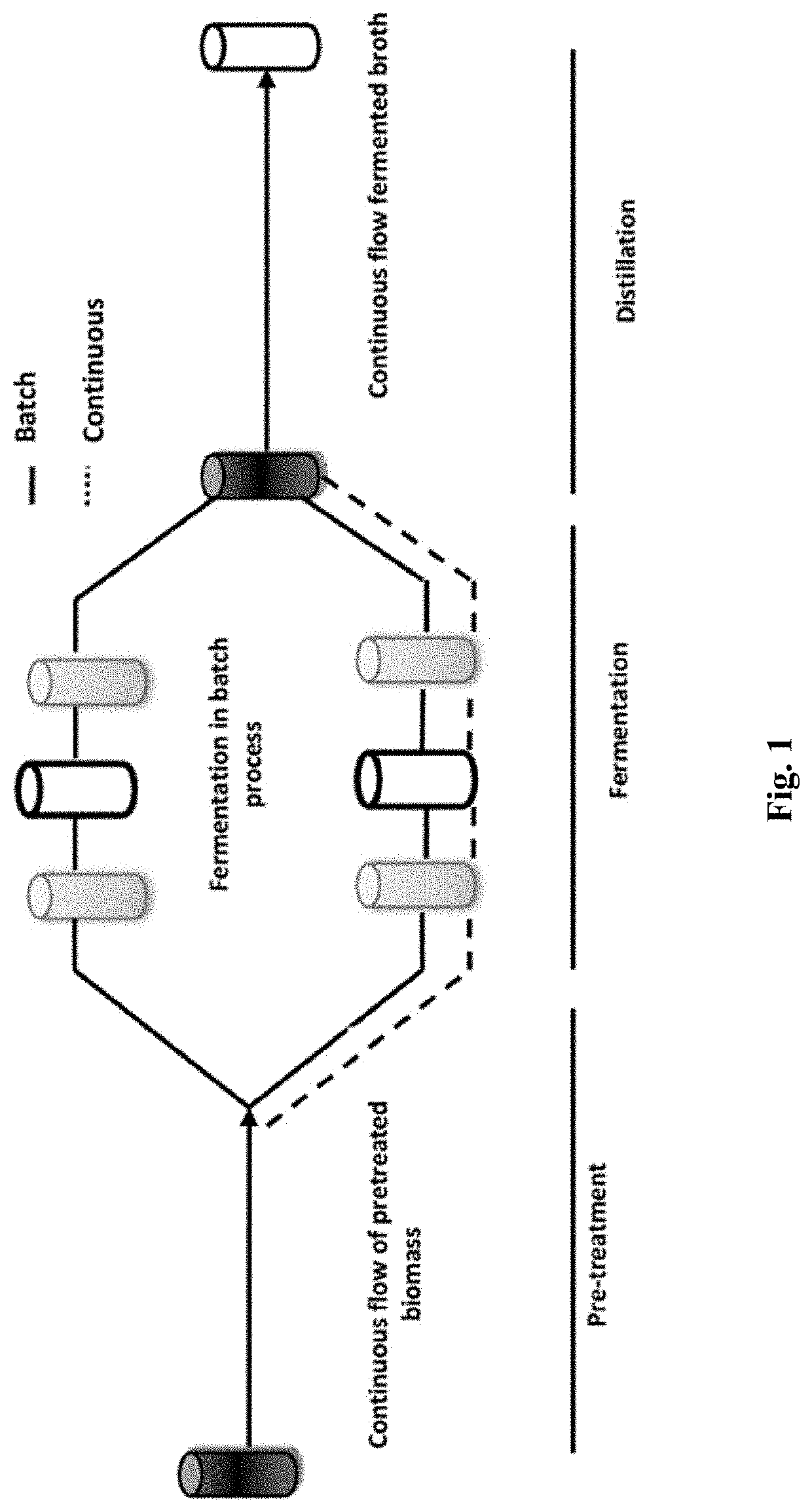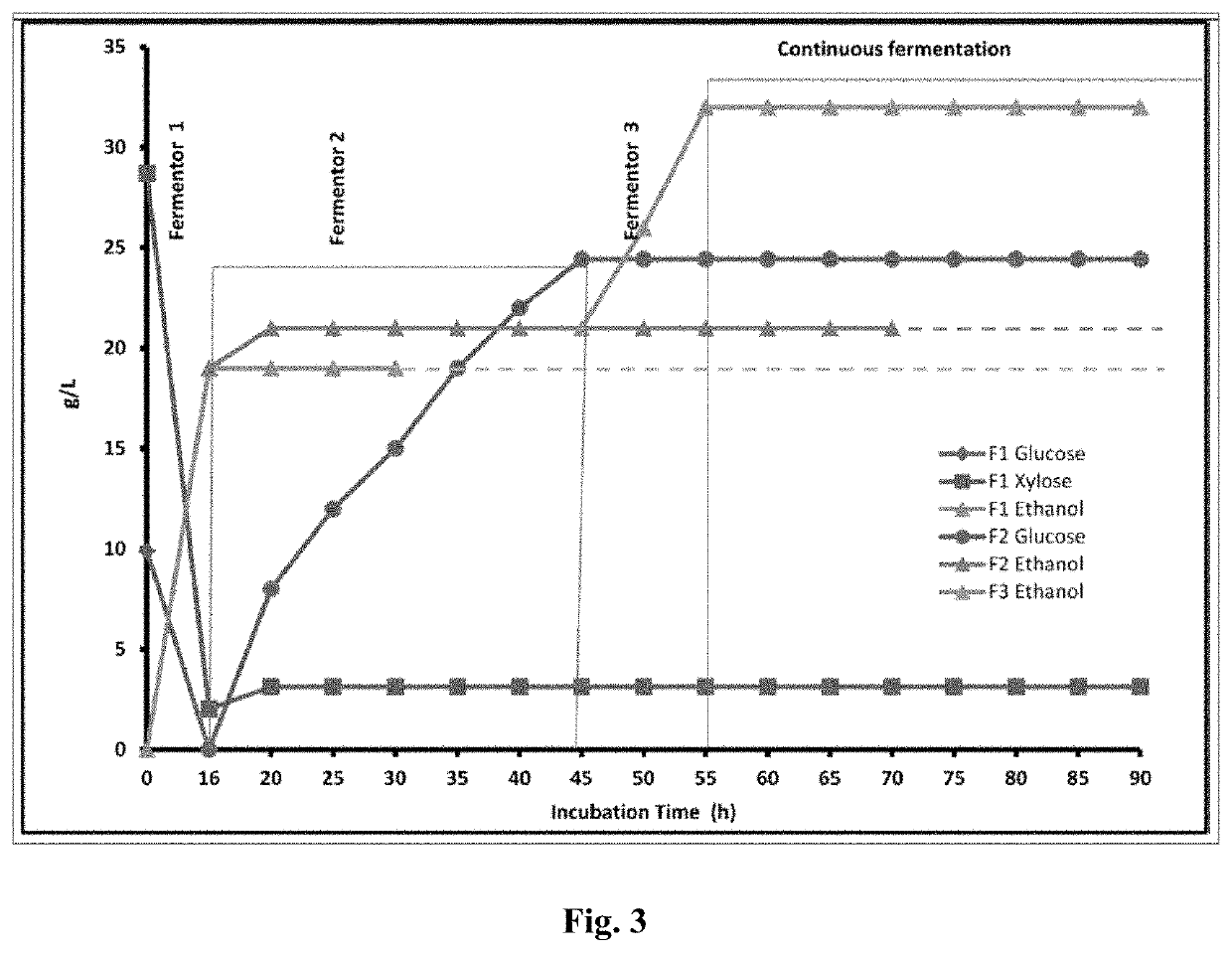Method for continuous second-generation ethanol production in simultaneous saccharification and co-fermentation process
a second-generation ethanol and co-fermentation technology, applied in the direction of biofuels, fermentation, etc., can solve the problems of reducing the overall reaction time and reactor volume of ssf/sscf, and achieve the effect of short fermentation time, low enzyme dose, and high ethanol titer
- Summary
- Abstract
- Description
- Claims
- Application Information
AI Technical Summary
Benefits of technology
Problems solved by technology
Method used
Image
Examples
example 1
[0064]Process for Continuous Production of Second-Generation Ethanol from a Lignocellulosic Biomass:
[0065]Pretreated biomass (slurry, TS approximately 20-22%) without any detoxification is introduced directly to the first fermentor vessel of the fermentor system. The pH of the slurry was adjusted to 5-5.5 with aqueous ammonium solution (25% initial concentration). The pH adjusted slurry was fortified with MgSO4 (0.5%), cellulase enzyme (in-house enzyme / Ctec, 2.3 FPU / TS) and co-fermenting ethanologenic yeast Saccharomyces cerevisiae (1 g dry cell biomass / 100 gTS, xylose utilizing genetically modified yeast). Required amount of water was added to the process to maintain the final biomass concentration to 15%. The whole process was incubated at 33° C. for 16 hours for the xylose fermentation. The fermented broth is then transferred to second fermentor vessel of the fermentor system and is allowed for hydrolysis at 50° C. for 30 hours. The volume of the reactor is maintained at 1.87 tim...
example 2
[0066]Process for Batch Production of Second-Generation Ethanol from a Lignocellulosic Biomass (Main Indian Patent Application No. 201821008982)
[0067]The pH of the pretreated slurry was adjusted to 5.5 with aqueous ammonium solution (25% initial concentration). The pH adjusted slurry was fortified with 3 g / l MgSO4, cellulase enzyme (Commercial enzyme, 3.3 FPU / TS) and co-fermenting Saccharomyces cerevisiae (1 g dry cell biomass / litre, xylose and glucose utilizing yeast). Required amount of water was added to the process to adjust the final biomass concentration to 20%. The whole process was incubated at 30° C. for 16 h for the fermentation with 200 rpm. When the free xylose concentration in the slurry comes near to 6-7 g / 1, the temperature of the process was increased to 33° C. and 35° C., incubated for 2 h in each temperature for better hydrolysis and fermentation. After that temperature increased to 48° C. This step mainly required for rapid releases of glucose sugar from cellulose...
PUM
| Property | Measurement | Unit |
|---|---|---|
| temperature | aaaaa | aaaaa |
| temperature | aaaaa | aaaaa |
| hydraulic reaction time | aaaaa | aaaaa |
Abstract
Description
Claims
Application Information
 Login to View More
Login to View More - R&D
- Intellectual Property
- Life Sciences
- Materials
- Tech Scout
- Unparalleled Data Quality
- Higher Quality Content
- 60% Fewer Hallucinations
Browse by: Latest US Patents, China's latest patents, Technical Efficacy Thesaurus, Application Domain, Technology Topic, Popular Technical Reports.
© 2025 PatSnap. All rights reserved.Legal|Privacy policy|Modern Slavery Act Transparency Statement|Sitemap|About US| Contact US: help@patsnap.com



